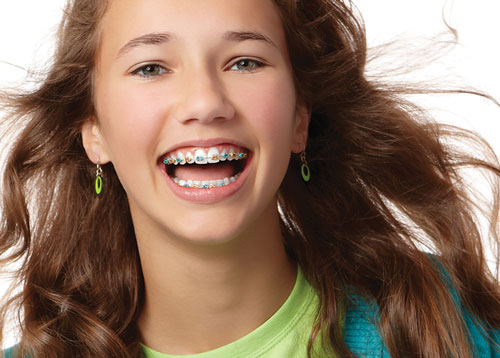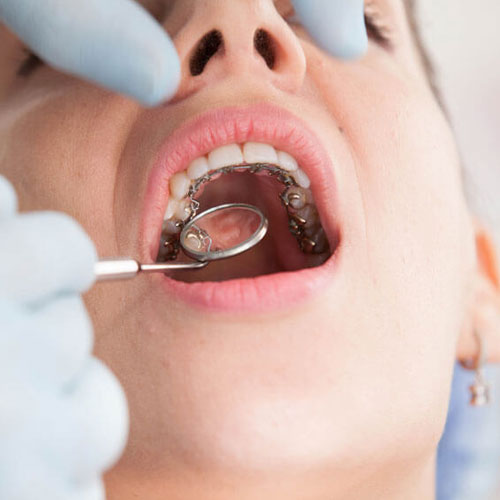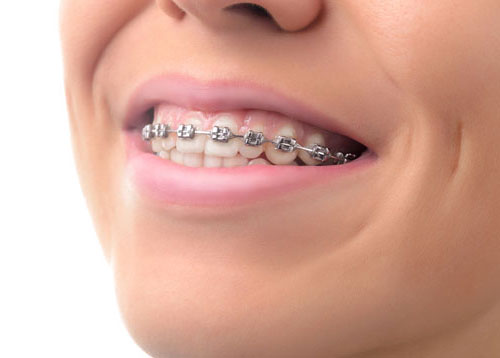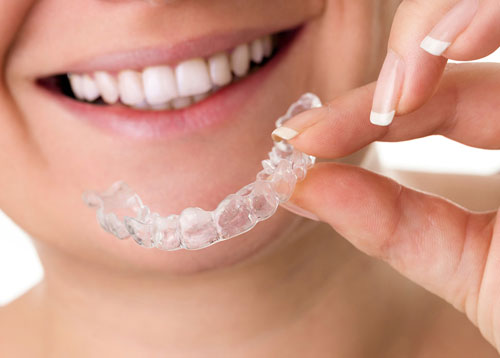Types of Braces

Metal Braces
Often also called “traditional braces,” metal braces have two basic components. These are the metal bracket that is applied to the teeth and the bendable metal wire that is threaded through the brackets in order to apply pressure to the teeth and ultimately move them. This is the type of braces that most teenagers get, because they are the least expensive version and are often the fastest way of moving teeth into their ideal locations.
In the past, the brackets and wires used for metal braces were very noticeable and could be annoying to those who wore them because of their size and intrusiveness. Today’s metal braces are far smaller and less noticeable than they were in the past. New technology has also created wires that move teeth faster and with less pain than in years past. Many teenagers also like the ability to choose the color of the rubber bands around each bracket, as this gives each person an opportunity to personalize their braces.
Ceramic Braces
Ceramic braces were once a very popular alternative to metal braces. Because the brackets were made out of a ceramic material that is the same color and has the same texture as teeth, it would be very difficult to see the ceramic brackets on the teeth. Many orthodontists would also use wires that were the color of the patient’s teeth, so the entire treatment would be virtually impossible to see. Because they were far less noticeable than metal braces, once the system was developed, it was in high demand.
Ceramic braces are still offered by some orthodontists today. While they are more expensive than traditional braces, they are far less noticeable and offer the patient a faster treatment than can be found with treatments like Invisalign. Like real teeth, however, the brackets could easily stain if the patients were not diligent and stuck to their cleaning schedule, and the ceramic braces and metal wires often had the same level of discomfort as traditional metal braces did.


Lingual Braces
Essentially the exact same as metal braces, except that they are on the inside of the bite, instead of on the outside, lingual braces provide a number of benefits. They can be just as effective as traditionally placed braces, whether of metal or ceramic, but they cannot be seen from outside of the mouth. While they can be spotted when the wearer opens their mouth, they are far less intrusive and likely to be noticed than brackets and wires on the front of the teeth.
Lingual braces come along with a number of negatives that make them an inappropriate choice for many patients. They can be very difficult to keep clean, as the wearer cannot see the braces, nor is he used to cleaning the area that he now has to clean extensively. They can also make it difficult to talk. Like all orthodontic treatments, there is a learning curve for speech, but lingual braces are often more difficult than other types of braces.
Lingual braces are also not a good option for those that have severe orthodontic conditions that need extensive treatment. And because they take longer and are often more expensive than traditional braces, most patients do not opt for this type of treatment.
Self-Ligating Braces
Similar to traditional metal and ceramic braces, self-ligating braces make use of the bracket and wire system. This may be the type of braces that most orthodontist use today, but many still use a more traditional system. This type of braces uses brackets with clips or doors that hold on to the wire, instead of the rubber band tie system. These braces are supposed to hold on to less food and be less painful than other types of braces, and they are also supposed to reduce the number of trips to the orthodontist the patient has to make.
This type of braces can be found in both metal and ceramic versions, but they are not the right choice for every patient. While they do shorten treatment periods, they might not provide all of the features that a patient needs in order to have a successful orthodontic treatment.


Invisalign® Teen
Invisalign® Teen can be every bit as effective as traditional braces for most common teeth-straightening cases, but only when worn the recommended 20-22 hours a day, every day, so it’s very important for your teen to be reliable with this. Many parents worry that this will be an issue, but a clinical study actually showed that teens wear their aligners more responsibly than most adults! If you’re still not convinced, we’ve got you covered: each Invisalign® Teen aligner has a blue indicator that will fade over time when used as directed. This allows me to keep up with and track each patient’s progress and compliance.
Invisalign® can successfully treat most mild to moderate cases of underbite, overbite, overcrowding, and gaps between the teeth. Although not every teen is a candidate for Invisalign, most will be, so get in touch with us to find out if it’s a good fit for your teen.
Invisalign®
Invisalign is the most common and the most effective system of invisible aligner “braces” on the market. While they are not ideal for every patient, they do provide a number of benefits, including the ability to completely remove the treatment to clean the teeth and the aligners when necessary. They are essentially invisible and once the patient is used to wearing them, they can be far more comfortable than metal braces.
Invisalign is usually more expensive than traditional braces, and the system does not yet have solutions for very severe orthodontic conditions. It does, however, make a great choice for those who want a more flexible treatment for fairly standard alignment issues.


Retention
It can take time, even after your braces come off, for your teeth to stay in place. Depending on your orthodontist’s recommendation, you may need to wear your retainer for 24 hours a day for the first three months, except for at meal time. If your teeth were severely misaligned, it can take up to a year or more for things to truly stabilize. Your orthodontist may recommend you continue to wear a retainer for at least part of every day after this first 12-month period to maintain a new, straightened position.
Retainers are ultimately made to fit the exact shape and placement of your teeth, and can either be removable or permanent to this end. Whether your orthodontist advises that you wear a removable or permanent retainer – or, in some cases, both – a retainer’s main purpose is to hold your teeth in the places to which your braces originally guided them.
